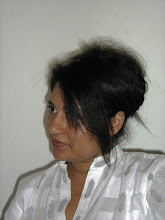
Thursday, March 11, 2010
Sunday, February 3, 2008
Dinner for Six: Inside Out (2007)
Tuesday, January 22, 2008
Saturday, January 19, 2008
Comfort Zones: Art of Anoli Perera by Jagath Weerasinghe
The Sri Lankan art scene is mostly 'inhabited' by members of the 'male species' rather than by its opposite sex. I am reluctant to use the word 'dominated' here, as it may not accurately reveal the historical and social processes and anxieties that have caused the presence of more men in the world of Sri Lankan art. It is a context where there is an almost complete absence of art historiography, no art publication in general, no tradition of art criticism, and no art museum. Furthermore, it is a context where the success in the art market is more decided by one's social links to the English speaking upper-middle class 'society' in Colombo, rather than by innovativeness or criticality in art. In the contemporary art scene of Sri Lanka, it is Anoli Perera who has contributed most, unbridled for the past 12 years to formulate the idea of a 'woman artist', who is consciously engaged in the construction of an artistic personality / identity by way of themes, materials, techniques and issues that are embedded in the discourse of 'the feminine', 'the beautiful' and 'the family'.
The interventionist nature of Perera's artistic personality first came into focus in her late 1990's series of paintings titled 'Aditi'. Since then, she has deployed her creative-critical energy to investigate issues pertaining to the roles expected to be played by women in a society that is neither modern nor traditional, but largely para-modern. Her works present us with two distinct lines of inquiry into the 'being of woman'. On the one hand, she has been questioning the position of woman as a social being, within which she is expected to wear the burdensome marks (signs /traits) of a culture depriving them of their sense of agency as individuals. On the other hand, she has been looking into the role of women as 'mother' or 'bride', or as the person who faces the brunt of the tension of conflicts inside the 'home-family' domain. Her past works such as 'Dinner for Six' (which is also exhibited in the current show) and 'I am the Queen' have been mostly directed towards investigating the intriguing and coercive roles imposed upon women by the cultural discourse of family.
In her recent works, the sculptures titled 'Silent Grievers' and the series of paintings named 'Comfort Bodies' she has reinvestigated with a certain sense of poignancy, the life of women caught in the discourse of family.
Anoli Perera is at her best when she engages in making labor-intensive art works, an exercise in which she locates herself in the intermediate zone between craft and art. Perera constructs her work by weaving, by placing or by suturing a single unit, piece by piece together as if she were solving or making a puzzle carefully. At the end of this process of solving/making a puzzle, she leaves a sense of tentativeness on the works in terms of the possible visual pleasures that the work can offer to its observers!
This rather evasive aspect of her works is most evident in the 'Silent Grievers', a series of sculptures and in the series of paintings, 'Comfort Bodies'. The macabre and ornamental ' Silent Grievers' could be seen as metaphor for fecundity. They can also stand for the ‘consequences' of fertility in the context of which aging women long for the closeness of children at the end of their life marked by grief. Through a closer examination one can sense that the signs of femininity are belied by the fractured and sutured surfaces that silently grieve due to ‘pain’. These works that are both bizarre and beautiful marks a fresh turn in Perera's career.

.jpg)










